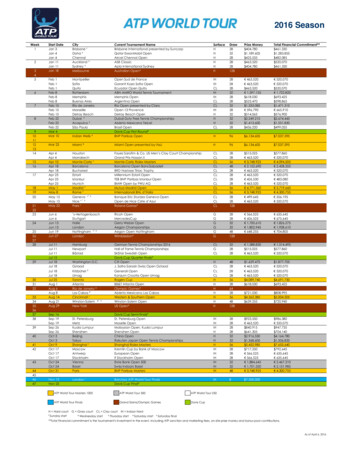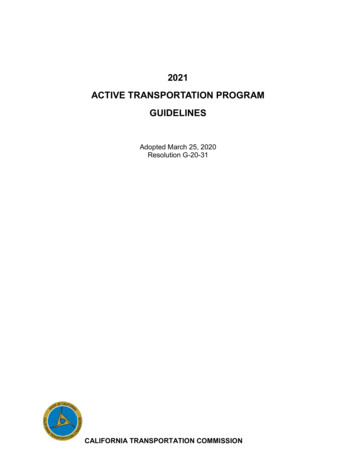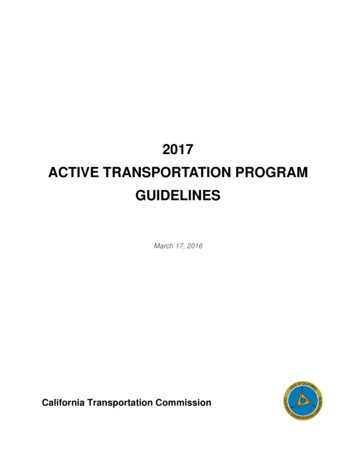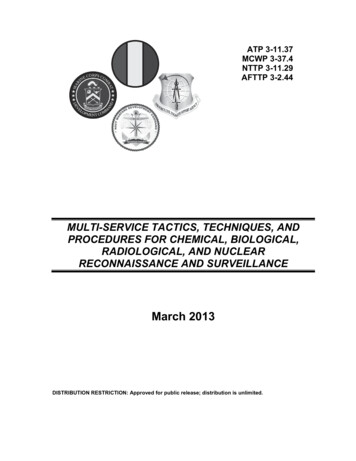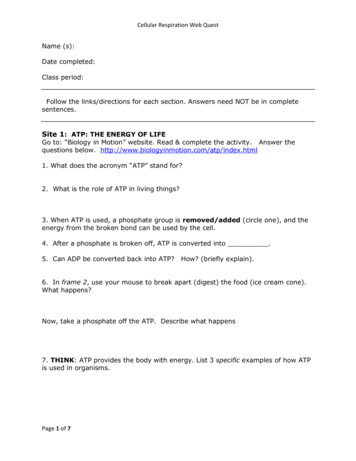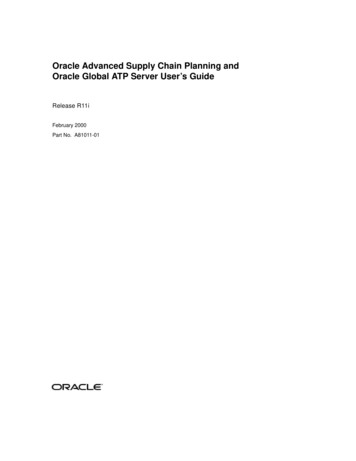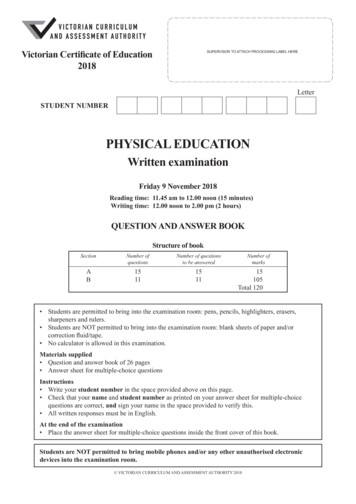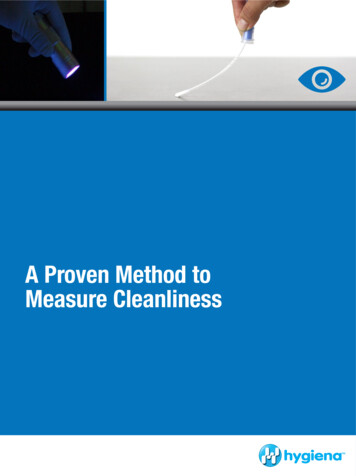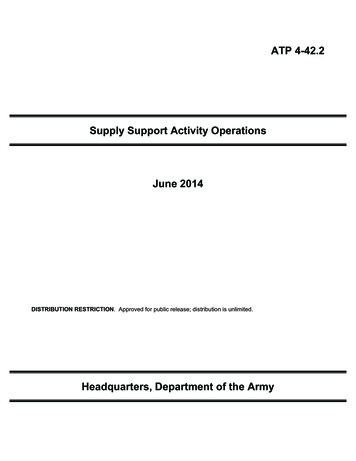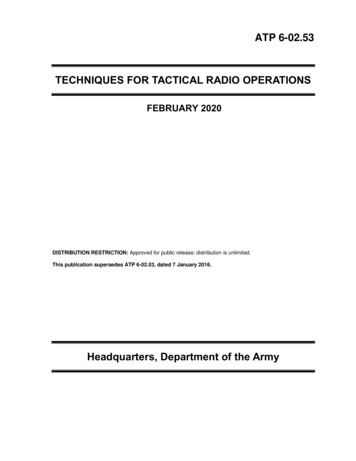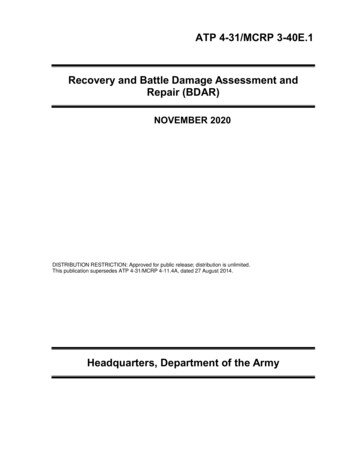
Transcription
ATP 4-31/MCRP 3-40E.1Recovery and Battle Damage Assessment andRepair (BDAR)NOVEMBER 2020DISTRIBUTION RESTRICTION: Approved for public release; distribution is unlimited.This publication supersedes ATP 4-31/MCRP 4-11.4A, dated 27 August 2014.Headquarters, Department of the Army
This publication is available at the Army Publishing Directorate site(https://armypubs.army.mil), and the Central Army Registry d).
ATP 4-31/MCRP 3-40E.1Army Techniques PublicationNo. 4-31Marine Corps Reference PublicationNo. 3-40E.1HeadquartersDepartment of the ArmyWashington, D.C.Marine Corps Logistics Operations GroupMarine Air-Ground Task Force Training CommandTwentynine Palms, CA18 November 2020Recovery and Battle Damage Assessment andRepair (BDAR)ContentsPagePREFACE. viiINTRODUCTION . ixChapter 1OVERVIEW FOR RECOVERY AND BDAR . 1-1Two Level Maintenance . 1-1Recovery. 1-2Expedient Repair . 1-3BDAR . 1-3Recovery, Expedient Repairs, and BDAR within the Army Strategic Roles . 1-4Chapter 2SUPPORT AND MAINTENANCE ORGANIZATIONS . 2-1Strategic Level . 2-1Sustainment and Manuever Units . 2-5Marine Corps Organizations . 2-8Chapter 3PLANNING FOR RECOVERY AND BDAR . 3-1Maintenance Planning . 3-1Operator Level Planning . 3-3Marine Corps Recovery and BDAR Planning. 3-3Chapter 4RIGGING . 4-1Rigging Equipment . 4-1Resistance . 4-16Mechanical Advantage . 4-23Determining Line Forces . 4-24Rigging Techniques . 4-28Chapter 5RECOVERY . 5-1General Safety Precautions. 5-1Operator/Driver Safety. 5-4Dedicated Recovery Procedures . 5-6Special Recovery Situations . 5-22Self-Recovery and Like Vehicle Recovery . 5-26DISTRIBUTION RESTRICTION: Approved for public release; distribution is unlimited.*This publication supersedes ATP 4-31/MCRP 4-11.4A, dated 27 August 2014.ATP 4-31/MCRP 3-40E.1i
ContentsExpedient Recovery Techniques . 5-32Remobilizing Tracked Vehicles . 5-33Chapter 6NON-STANDARD REPAIRS . 6-1Unit Responsibility. 6-1United States Army Materiel Command Responsibility . 6-1Expedient Repairs . 6-2Battle Damage Assessment and Repair . 6-3Special Operating Environments . 6-10BDAR and Expedient Repair Training . 6-11BDAR and Expedient Repair Definitions . 6-12Appendix AMULTINATIONAL RECOVERY AND BDAR OPERATIONS . A-1Appendix BHAND AND ARM SIGNALS . B-1Appendix CRECOVERY GUIDELINES FOR OPERATORS/LEADERS . C-1GLOSSARY . Glossary-1REFERENCES. References-1INDEX . Index-1FiguresFigure 3-1. The maintenance planning process . 3-1Figure 4-1. Typical pulley blocks and snatch blocks . 4-1Figure 4-2. Block classifications . 4-2Figure 4-3. Fixed, running and floating blocks attached to a load. . 4-3Figure 4-4. Wire rope characteristics . 4-5Figure 4-5. Strand and wire arrangements . 4-5Figure 4-6. Measuring rope diameter . 4-5Figure 4-7. Typical chain markings . 4-7Figure 4-8. Typical hooks. 4-8Figure 4-9. Typical anchor shackles . 4-9Figure 4-10. Typical chain shackles . 4-9Figure 4-11. Typical constant pull winch . 4-11Figure 4-12. Proper and improper cable tensioning . 4-11Figure 4-13. Anchor symbol . 4-12Figure 4-14. Examples constructed and natural anchors . 4-13Figure 4-15. Single vehicle anchor self-winching . 4-13Figure 4-16. Tandem vehicle anchor . 4-14Figure 4-17. Typical Scotch anchor . 4-14Figure 4-18. Typical log deadman . 4-15Figure 4-19. Mire factors . 4-17Figure 4-20. Grade resistance . 4-17Figure 4-21. Overturning resistance . 4-19Figure 4-22. First-class lever . 4-21Figure 4-23. Second-class lever . 4-22iiATP 4-31/MCRP 3-40E.118 November 2020
ContentsFigure 4-24. Simple tackle system . 4-22Figure 4-25. Compound tackle system . 4-23Figure 4-26. Mechanical advantage of tackle systems . 4-24Figure 4-27. Terminology of simple tackle . 4-25Figure 4-28. Examples of fleet angles. . 4-25Figure 4-29. Example of a unit generated recovery math worksheet for example 1 . 4-27Figure 4-30. 4 to 1 mechanical advantage, with two snatch blocks for example scenario 2 . 4-28Figure 4-31. Backup method of rigging . 4-29Figure 4-32. M88A2 lead method of rigging . 4-30Figure 4-33. Floating block for recovery towing . 4-31Figure 5-1. Unsafe areas during an angle pull . 5-2Figure 5-2. Hook positions (snatch blocks only) . 5-3Figure 5-3. Chocking/blocking wheeled vehicles . 5-5Figure 5-4. Safety keys and shackle pins . 5-5Figure 5-5. Winching using a 2-to-1 mechanical advantage and a change of direction block . 5-7Figure 5-6. Like vehicles preparing for flat towing. 5-8Figure 5-7. Cross-country towing . 5-9Figure 5-8. Winching with two recovery vehicles . 5-12Figure 5-9. 2-to-1 mechanical advantage . 5-12Figure 5-10. Tracked towing with holdback vehicle . 5-13Figure 5-11. Tracked towing . 5-14Figure 5-12. Chocking/blocking tracked vehicles . 5-16Figure 5-13. Classifying a grade . 5-17Figure 5-14. Slope surveying level . 5-18Figure 5-15. Eyesight and pace method . 5-18Figure 5-16. Fifth wheel towing device . 5-19Figure 5-17. The modular catastrophic recovery system . 5-20Figure 5-18. Tilt deck recovery trailer. . 5-21Figure 5-19. Recovery of a nosed-in cargo truck . 5-22Figure 5-20. Recovery of overturned and upright with wreckers . 5-23Figure 5-21. Recovery of overturned track vehicle . 5-24Figure 5-22. A recovery vehicle winching a nosed tracked vehicle . 5-26Figure 5-23. Lifting operation . 5-26Figure 5-24. Recovery extraction of a mired cargo truck in tandem . 5-27Figure 5-25. Winching with like or heavier class wheeled vehicle . 5-28Figure 5-26. Self-recovery operation . 5-28Figure 5-27. Recovery of a mired tank using one like vehicle . 5-29Figure 5-28. Recovering a nosed tracked vehicle with like vehicles . 5-29Figure 5-29. Recovering an overturned tracked vehicle with like vehicles . 5-30Figure 5-30. Using a log to anchor tracks . 5-33Figure 5-31. Cables used to anchor tracks . 5-3418 November 2020ATP 4-31/MCRP 3-40E.1iii
ContentsFigure 5-32. Moving a vehicle with both tracks broken . 5-35Figure 5-33. Moving a vehicle onto a track . 5-35Figure 5-34. Installing a track. 5-36Figure 6-1. Example of a DA Form 2404 . 6-9Figure 6-2. Example of computer generated DA Form 5988-E . 6-10Figure B-1. Signal for attention . B-2Figure B-2. Signal for start engine . B-3Figure B-3. Signal for decrease speed and slow down . B-3Figure B-4. Signal for move forward . B-4Figure B-5. Signal for move backward . B-4Figure B-6. Signal for turn right . B-5Figure B-7. Signal for turn left . B-5Figure B-8. Signal for pivot right . B-6Figure B-9. Signal for pivot left . B-6Figure B-10. Signal for neutral steer right . B-7Figure B-11. Signal for neutral steer left . B-7Figure B-12. Signal for button-up . B-8Figure B-13. Signal for unbutton . B-8Figure B-14. Signal for close the distance and stop . B-9Figure B-15. Signal for emergency stop . B-9Figure B-16. Signal for stop . B-10Figure B-17. Signal for stop engine . B-10Figure B-18. Signal for attention . B-11Figure B-19. Signal for start engine . B-12Figure B-20. Signal for lower spade/outriggers . B-12Figure B-21. Signal for raise spade/outriggers . B-13Figure B-22. Signal for button-up . B-13Figure B-23. Signal for unbutton . B-14Figure B-24. Signal for payout the winch cable . B-14Figure B-25. Signal for inhaul the main winch cable . B-15Figure B-26. Signal for use the main line . B-15Figure B-27. Signal for use the whip line . B-16Figure B-28. Signal for retract the boom . B-16Figure B-29. Signal for extend the boom . B-17Figure B-30. Signal for swing the boom to the right . B-17Figure B-31. Signal for swing the boom to the left . B-18Figure B-32. Signal for raise the boom . B-18Figure B-33. Signal for lower the boom . B-19Figure B-34. Signal for raise the hoist cable . B-19Figure B-35. Signal for lower the hoist cable . B-20Figure B-36. Signal for raise boom, lower load & lower boom, raise load . B-20ivATP 4-31/MCRP 3-40E.118 November 2020
ContentsFigure B-37. Signal for move slowly .B-21Figure B-38. Signal for close the distance and stop.B-21Figure B-39. Signal for emergency stop .B-22Figure B-40. Signal for stop.B-22Figure B-41. Signal for dog everything .B-23Figure B-42. Signal for stop engine .B-23TablesTable 4-1. Computing fiber rope load limit . 4-4Table 4-2. Wire rope safety factor . 4-6Table 4-3. Endless loop slings and screw-pin shackles . 4-10Table 4-4. Variable pull capacity . 4-12Table 4-5. Surface drag coefficients . 4-18Table 4-6. Determining gradient resistance in dedicated recovery operations . 4-18Table 4-7. Gradient values . 4-18Table 4-8. Estimated winch variable capacity . 4-20Table 4-8. Estimated winch variable capacity (Continued) . 4-21Table 4-9. Calculating required mechanical advantage . 4-23Table 4-10. Recovery math . 4-26Table 4-11. Determining dead line force example scenario 2 . 4-28Table 5-1. Eight step recovery method . 5-6Table 5-1. Eight step recovery method (Continued) . 5-7Table 5-2. Vehicle weights . 5-20Table 5-3. Prime movers for fifth wheel towing device. 5-20Table 6-1. Nonstandard repairs. 6-218 November 2020ATP 4-31/MCRP 3-40E.1v
This page intentionally left blank.
PrefaceATP 4-31/MCRP 3-40E.1, Recovery and Battle Damage Assessment and Repair, provides techniques onhow recovery and battle damage assessment and repair (BDAR) are employed during operations.The principal audience for ATP 4-31/MCRP 3-40E.1 is all members of the profession of arms.Commanders and staffs of Army headquarters serving as joint task force or multinational headquartersshould also refer to applicable joint or multinational doctrine concerning the range of militaryoperations and joint or multinational forces. Trainers and educators throughout the Army will also usethis publication.Commanders, staffs, and subordinates ensure their decisions and actions comply with applicable UnitedStates, international, and in some cases host-nation laws and regulations. Commanders at all levels ensuretheir Soldiers operate in accordance with the law of war and the rules of engagement. See FM 6-27/ MCTP11-10C, The Commander’s Handbook on the Law of Land Warfare.ATP 4-31/ MCRP 3-40E.1 implements the following standardization agreements:STANAG 2418, Edition 2, Procedures for Expedient Repair, Including Battle Damage Repair (BDR).STANAG 2633 – Maintenance Support of Land Operations.STANAG 4101 – Towing Attachments.STANAG 4478 - Towing and Recovery Facilities for Tactical Land Vehicle.ATP 4-31/MCRP 3-40E.1 uses joint terms where applicable. Selected joint and Army terms and definitionsappear in both the glossary and the text. Terms for which ATP 4-31/MCRP 3-40E.1 is the proponentpublication (the authority) are italicized in the text and are marked with an asterisk (*) in the glossary.Terms and definitions for which ATP 4-31/MCRP 3-40E.1 is the proponent publication are boldfaced in thetext. For other definitions shown in the text, the term is italicized and the number of the proponentpublication follows the definition.ATP 4-31/MCRP 3-40E.1 applies to the Active Army, Active Marines, Army National Guard, United StatesArmy Reserve, and Marine Corps unless otherwise stated.The proponent of ATP 4-31/MCRP 3-40E.1 is the United States Army Ordnance School. The preparingagency is the Combined Arms Center (CASCOM) G-3 Training and Doctrine Development Directorate.Send comments and recommendations on DA Form 2028 (Recommended Changes to Publications andBlank Forms) to Commander, United States Army CASCOM, ATTN: ATCL-TS (ATP 4-31), 2221 AdamsAve., Fort Lee, VA 23801; or submit an electronic Department of the Army (DA) Form 2028 by email to: l. United States Marine Corps readersof this publication are encouraged to submit suggestions and changes by email to doctrine@usmc.mil orby mail to the Commanding General, United States Marine Corps, Training and Standards Division,Doctrine Branch, 1019 Elliot Road, Quantico, Virginia 22134-5010.18 November 2020ATP 4-41/MCRP 3-40E.1vii
This page intentionally left blank.
IntroductionSoldiers, Marines, and officers who perform recovery operations and battle damage assessment and repairfor their service perform a vital role of keeping units and personnel safe while maintaining and providing theeffective operational readiness rates required to accomplish the mission. Recovery personnel, as identified inthis publication, includes every person that plays a role in recovery operations or battle damage assessmentand repair. This includes professional recovery personnel, such as maintenance control officers, warranttechnicians and maintenance teams.All personnel involved in recovery operations/battle damage assessment and repair need to understand theenvironment in which they operate. This manual provides information on recovery support to unit operationsincluding operations within the Joint environment.It is imperative for all personnel engaged in recovery operations or battle damage assessment and repairsupport operations to have an understanding of the various staff organizations that have a role in recoveryplanning and support. It will be necessary for a recovery support activity to contact the higher, lower, oradjacent headquarters (both sustainment and operational) to coordinate support, report status, requesttechnical assistance, or request additional resources. This manual presents the roles and missions of thevarious recovery organizations to enhance coordination.Readers should follow the guidelines in this publication as closely as possible within the constraints andrestrictions of the tactical situation.Army Techniques Publication (ATP) 4-31, Recovery and Battle Damage Assessment and Repair (BDAR), isa revision of the 27 August 2014 publication. ATP 4-31 provides an overview of battlefield recovery, andbattle damage assessment and repair for the fundamental purpose of returning combat assets to the battlefieldas soon as possible. This publication presents the different types and methods used in recovery operations aswell as guidance on the assessment and repair of battle-damaged equipment. This publication also reviewsthe rigging procedures and the utilization of mechanical advantage to accomplish recovery missions. Thispublication provides an overview of common recovery methods, techniques, and safety precautions for useby dedicated recovery personnel. The major change to ATP 4-31 from the previous version is the discussionof expedient repair and planning considerations for recovery operations and BDAR across all echelons.ATP 4-31 is comprised of six chapters: Chapter 1 provides an overview of two-level maintenance, expedient repair, battlefield recovery,and BDAR. It also discusses the importance of recovery and BDAR within the Army strategicroles. Chapter 2 provides an overview of supporting organizations providing guidance and assistancewithin an area of operation. The chapter also provides information on units providing recoveryand BDAR support. Chapter 3 provides an overview of the planning process utilized in recovery operations. It alsoidentifies the key personnel who plan for recovery and BDAR operations, the chapter also providesplanning considerations for Marine Corps recovery and BDAR. Chapter 4 explains rigging methods and techniques, and explains how to utilize mechanicaladvantage in recovery operations. Chapter 5 identifies various examples of recovery techniques including those utilized by driveroperators and those reserved for dedicated recovery personnel. Chapter 6 clearly delineates the differences between technical manual (TM) repairs, expedientrepairs, and BDAR, identifies examples of improvised repair procedure utilized to rapidly returndisabled equipment to operational condition in wartime.ATP 4-31 does not introduce, modify, or rescind any Army term or acronym.18 November 2020ATP 4-41/MCRP 3-40E.1ix
This page intentionally left blank.
Chapter 1Overview for Recovery and BDARBattlefield recovery and battle damage assessment and repair (BDAR) are separate anddistinct subsets of maintenance. Both are the owning unit’s responsibilities and bothhave a funda
ATP 4-31/MCRP 3-40E.1, Recovery and Battle Damage Assessment and Repair, provides techniques on how recovery and battle damage assessment and repair (BDAR) are employed during operations. The principal audience for ATP 4-
